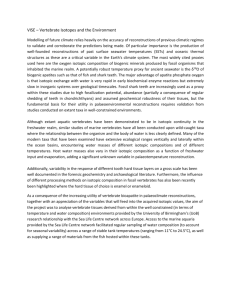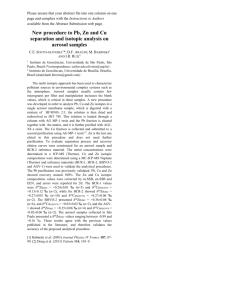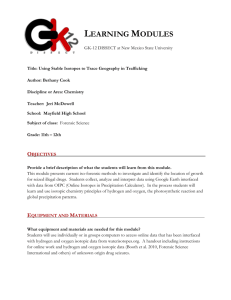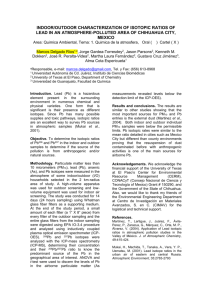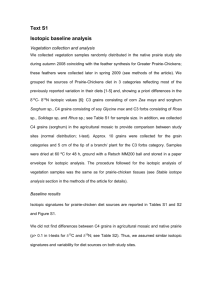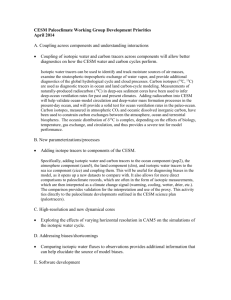rcm7201-sup-0001-Supplementary
advertisement
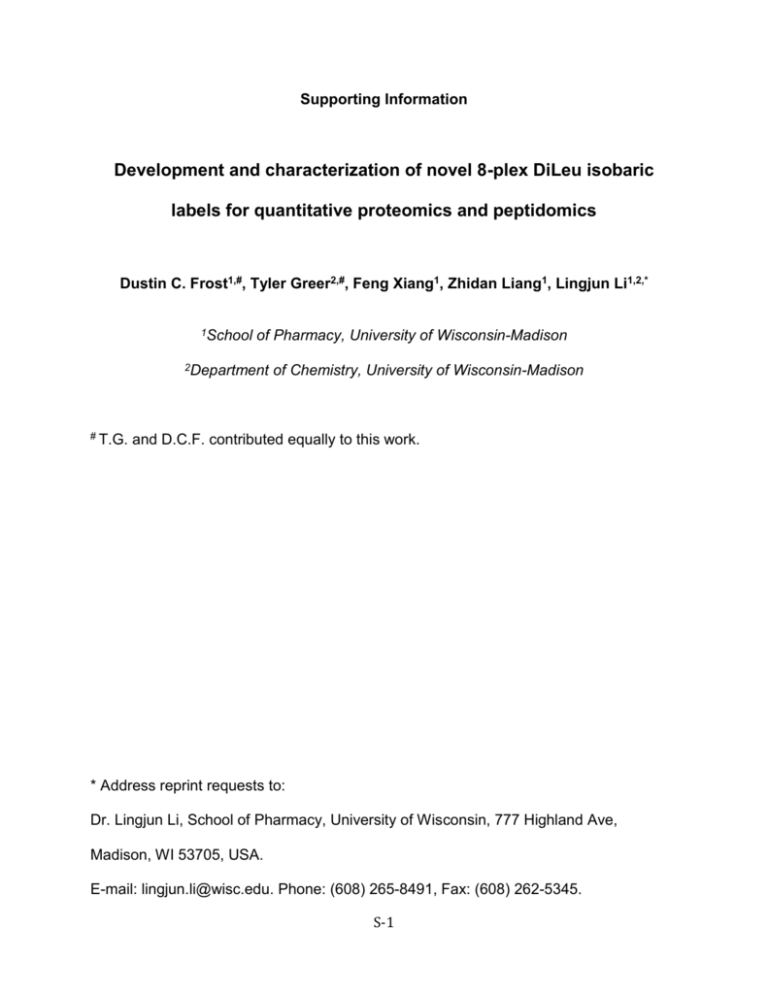
Supporting Information Development and characterization of novel 8-plex DiLeu isobaric labels for quantitative proteomics and peptidomics Dustin C. Frost1,#, Tyler Greer2,#, Feng Xiang1, Zhidan Liang1, Lingjun Li1,2,* 1School of Pharmacy, University of Wisconsin-Madison 2Department # T.G. of Chemistry, University of Wisconsin-Madison and D.C.F. contributed equally to this work. * Address reprint requests to: Dr. Lingjun Li, School of Pharmacy, University of Wisconsin, 777 Highland Ave, Madison, WI 53705, USA. E-mail: lingjun.li@wisc.edu. Phone: (608) 265-8491, Fax: (608) 262-5345. S-1 SUPPLEMENTAL METHODS Yeast lysate enzymatic digestion Saccharomyces cerevisiae lysate was provided by Promega (Madison, WI). Protein disulfide bonds were reduced in a solution of 5mM DTT with 7 M urea in 80 mM ammonium bicarbonate pH 8 at 37 °C for 30 min followed by alkylation of free thiols by addition of IAA to 15 mM and incubation in the dark for 30 min. The solution was diluted to 1 M urea with 50 mM Tris-HCl pH 8, and proteins were digested by addition of trypsin/Lys C mix (Promega, WI) at a 50:1 protein: enzyme ratio and incubation at 37 °C for 16 h. The digestion was quenched by acidification to pH <3 using 10% TFA, and the peptides were desalted using a SepPak C18 SPE cartridge (Waters, Milford, MA). Digested peptides were divided into eight equal aliquots in triplicate, dried in vacuo, and dissolved in 60:40 ACN:H2O prior to labeling. S-2 SUPPLEMENTAL FIGURES Scheme S-1 • 8-plex DiLeu reagent general synthesis. 8-plex DiLeu reagents are synthesized in five or six steps. Four of the labels require 18O exchange of leucine or isotopic leucine. Leucine or isotopic leucine undergoes reductive dimethylation with formaldehyde or isotopic formaldehyde using sodium cyanoborohydride or sodium cyanoborodeuteride in water or deuterium oxide. Alanine or isotopic alanine undergoes benzyl esterification with benzyl alcohol and phosphoric acid. N,N-dimethyl leucine and alanine benzyl ester are coupled using N-ethyl-N′-(3-dimethylaminopropyl) carbodiimide hydrochloride (EDC), and the benzyl ester product is converted to the carboxylic acid form via Palladium over activated charcoal (Pd/C) catalyzed hydrogenation. The DiLeuAlaOH product is activated to the NHS ester form using Nhydroxysuccinimide (NHS) and N,N’-diisopropylcarbodiimide (DIC). S-3 Scheme S-2 • 8-plex DiLeu reagent structures, synthetic steps, and isobaric starting materials. The isotopic substitution positions, synthetic steps, and isotopic starting materials are summarized for each of the 8-plex DiLeu reagents. * - A 114 reagent synthesis is also possible but was omitted from this work due to increased synthetic complexity and isotopic materials cost. S-4 115 116 117 118 119 120 121 122 -1 0.27% 11.60% 4.88% 0.12% 0.49% 7.55% 4.05% 5.12% 0 92.69% 83.80% 89.38% 94.25% 88.95% 86.91% 90.16% 90.22% +1 7.01% 4.57% 5.72% 5.59% 9.62% 5.32% 5.77% 4.56% Table S-1 • Primary and isotopic peak fractions of total reporter ion signal. The total reporter ion intensity for each 8-plex DiLeu channel is distributed across the primary reporter ion peak (0) and isotopic peaks (±1). Values were determined by separately analyzing BSA tryptic digests labeled with each channel on the Q-Exactive Orbitrap at an MS2 resolving power of 17.5k. Values for the 0 and ±1 peaks were determined by computing average intensities for each channel. S-5 Figure S-1 • Isotopic interference correction factor equations (at RP: 17.5k). Primary reporter ion and isotopic peak overlaps were determined on the Q-Exactive Orbitrap at an MSn resolving power of 17.5k. At this resolution, the primary reporter peak of channel 118 is interfered with by the -1 isotopic peak of channel 119, and a correction factor is applied. Equations for the observed raw signal were rearranged to solve for the corrected intensity using PTC Mathcad 14 (Needham, MA). These equations add the isotopic impurity peak intensity contributions to the reporter ion signals by dividing the observed signal (S) by the percent purity (x). The isotopic interference (z) adds to the signal for channel 118 and must be subtracted from the combined intensity (I). Instruments with lower MSn resolving power will need to determine isotopic peak interferences and adjust correction factor equations accordingly. S = raw observed signal; I = combined intensity; x = fraction of intensity observed as signal; z = fraction of intensity interfering with -1 isotopic peak. S-6 Figure S-2 • 8-plex DiLeu reporter ions. The isotopic substitution positions, chemical formulas, and exact masses of each of the 8-plex DiLeu reporter ions are shown. S-7 Figure S-3 • HCD normalized collision energy comparison. MS2 spectra of an 8-plex DiLeu labeled tryptic peptide acquired on the Q-Exactive Orbitrap using HCD fragmentation at NCE values of 24 and 39 are shown. At an NCE of 24, an abundance of b- and y-type peptide backbone fragment ions lead to a high XCorr value and confident peptide identification. At an NCE of 39, fewer peptide backbone fragment ions are observed due to secondary fragmentation resulting in overly abundant reporter ion signals. S-8 Figure S-4 • Reporter ion isotopic interferences. Each of the 8-plex DiLeu reporter channels was acquired separately at a MS2 resolving power of 17.5k on the Q-Exactive Orbitrap. The primary reporter ion peak and ±1 isotopic peaks of each channel are colored uniformly to illustrate interferences with neighboring channels. S-9 Figure S-5 • Deuterium effect on RPLC retention times of 8-plex DiLeu-labeled tryptic peptides. An eight-protein tryptic digest sample was labeled with 8-plex DiLeu and analyzed via RPLC-tMS2 on the Q-Exactive Orbitrap using a self-packed 15 cm BEH130 C18 micro capillary column and a 60 minute elution gradient. Seven arbitrarily chosen tryptic peptides were selected for targeted MS2 acquisition and the extracted ion chromatograms of each channel were compared to determine the retention time shifts of peptides labeled with channels 115-118 in relation to peptides labeled with channels 119-122. Retention time shifts were observed for the labeled peptides, and a shift of as much as 2.2 s was observed for AWSVAR. S-10 Figure S-6 • Effect of ratio normalization on quantitative precision. Quantitative ratios of identified PSMs for non-deuterated channels 119, 121, and 122 (box and whiskers) were calculated in relation to deuterated channel 115 (gray) or nondeuterated channel 120 (blue). Box plots demarcate the median (line, fixed at 1), the 25th and 75th percentile (box), and the 5th and 95th percentile (whiskers). S-11
